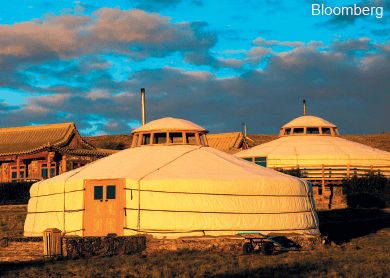05. The circular Zaisan Memorial was erected on top of a hill in the south of Ulaanbataar by the former Soviet Union to commemorate those killed in World War II. The colourful mural is worth the climb, as is the view of the city on a clear day. At the foot of the hill, there’s also a large Buddha statue and another memorial of a Soviet tank, which includes a map of its route from Moscow in 1943 to Berlin in 1945. Photo by AFP
06. The Winter Palace of the Bogd Khan. This museum on the southern edge of Ulaanbaatar was originally built in 1893, as the Winter Palace of Mongolia’s eighth Living Buddha and last emperor. Inside, you’ll discover his interest in all things animal: there’s a vast array of taxidermy, a robe made from 80 fox skins, and a yurt lined with snow leopard skins that’s uncomfortable viewing when you consider their current endangered status. But it’s not all furry stuff. The exhibits also include Mongolia’s 1911 Declaration of Independence from China, Buddhist art and sculpture, and the jewels worn by his pet elephant. Photo by AFP
07. The pristine Lake Khuvsgul, which sits at the foot of the Sayan Mountains in north-west Mongolia, bordering the great Siberian Taiga forest, is one of Asia’s largest freshwater lakes (84 miles long by 24 miles wide/135km by 39km). At over two million years old, it’s also one of the world’s 17 ancient lakes and is nearly 900ft deep, holding 70% of Mongolia’s fresh water. The province is teeming with wildlife and is home to some of the country’s oldest tribes, including the Tsaatan, or reindeer people, who have a lot in common with American Indians, continuing to live in deer hide tepees rather than gers. Photo by Tulga
08. Wrestling at Naadam Festival Wrestling, archery and horse racing are the “three manly sports” celebrated during the summer’s Naadam Festival, a national holiday which runs for three days each July. The uniforms of tight shorts, open jackets and traditional Mongolian boots are topped off with small hats — it’s said that the open jackets are due to a woman once taking part and winning (although women are welcome to compete in archery and horse racing). There’s no weight division, so expect a lightweight wrestler trying his luck against a burly opponent. There’s also no time limit, so two well-matched wrestlers can grapple for hours, giving you time to nip off for a khuurshuur (cold meat pancake). If any part of the body touches the ground (save the hands and, obviously, the feet), the match is over. The judges are then honoured with an eagle dance called the devekh, which is also performed in honour of the defeated opponent. Win five rounds and you’re given the title of “Falcon”, win seven and you’re an “Elephant”, while the much celebrated overall winner is a “Lion”. Photo by AFP
09. The Game of Kings, horse polo, may be a game for the rich and the royal in other parts of the world, but in Mongolia, where it’s been played for centuries — spread by the invading forces of Genghis Khan who used it to entertain and train his cavalry — it’s an altogether more egalitarian affair. Here, young polo players hone their skills in the Orkhon Valley polo camp. Photo by AFP
10. Kazakh eagle hunters. It’s highly unusual to find a girl hunting with a golden eagle, yet photographer Asher Svidensky discovered then 13-year-old Ashol-Pan doing just that. The Kazakhs of the Altai Mountains have been hunting this way in Western Mongolia for thousands of years. Boys start hunting at a young age, building power in their little arms to hold the heavy bird, and learning not to fear, but respect the birds of prey which they use to hunt hares and foxes. Mature golden eagles are set free to breed in the wild, with a butchered sheep to help them on their way. Photo by Svidensky


_Mongolia_fd110615.png)